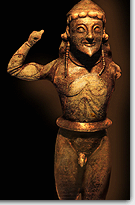A special style of sculpture owing quite a lot of its elements to oriental influences, had already been developed in Crete at the end of the 8th century B.C. At the same time the structuring of the volumes of the human body was gradually released from the formation and approached a more physiocratic conception. This tendency was expressed through a new technique, hammering. Characteristic examples from the end of this period are the three statues from Dreros, one male and two female, which are usually identified as the Apollonian trinity. They were made of hammered sheets of bronze, which were fixed with nails onto a wooden frame, and apparently constituted the cult statues of the temple of Dreros. During the same period, a similar technique can be found in human-head vases from Idaon cave and in cast statuettes from Cnossus, which verifies that this development was indigenous. With a combined technique (casting and hammering) another cult statue of Apollo Hoplites was apparently made; this was recently found in a temple of the ancient Metropolis, in west Thessaly. Although it is more recent - dated around the middle of the 6th century B.C.- it seems to be related to the same tradition, of that of the bust of Nike from Olympia. Some heads of griffins and lions, also from Olympia, have stronger Ionic influences. |  |














